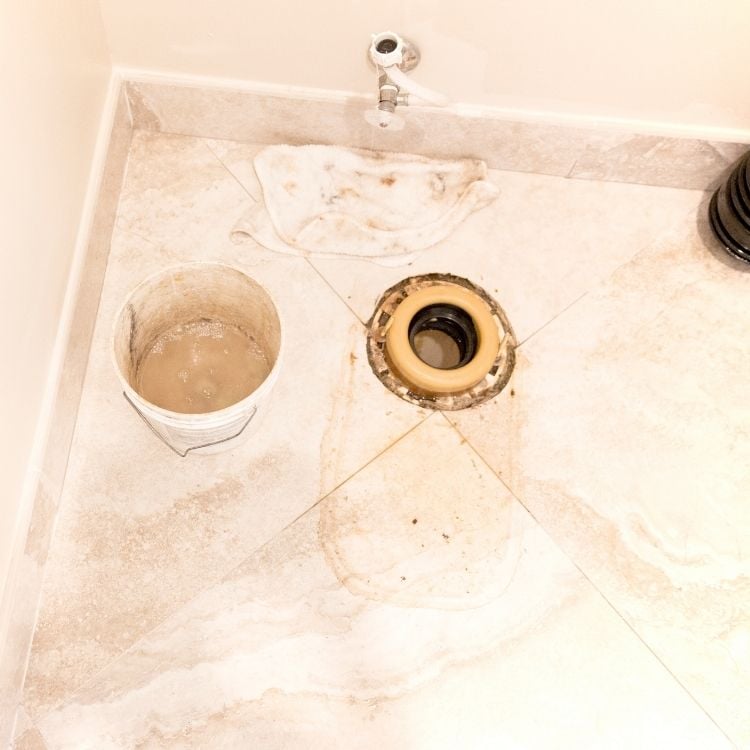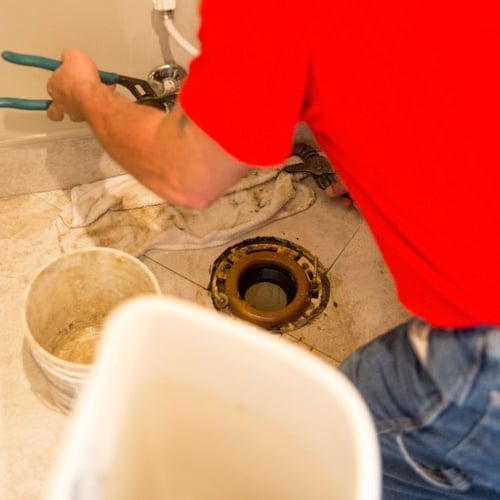What do your toilet and your camera lens have in common? Both require a flange to work! A toilet flange is an understated piece of a toilet’s installation. If you never had plumbing problems in the bathroom, you'd probably never know it was there. But, just in case something goes wrong, learning what a toilet flange is and how to replace it if needed is essential as a homeowner.
Like any flange type, a toilet flange is a round piece with a perpendicular collar. The collar of a flange fits either inside or outside of another item. It provides stability and guidance during operation. On a camera, the flange mounts the lens to the body of the camera. On a toilet, the flange is what secures the porcelain bowl to the floor. It also helps keep water from leaking on its way to the drainpipe.

Why do we call it a toilet flange?
The word “flange” refers to any collared piece of material that is used to help secure one object to another. These pieces are simple but essential in many fields. You can find a flange on anything from a gas pipeline to a ski boot.
“Flange” can be traced back to Old French, where it’s thought to originate from the word flanchir, which means to bend. A related word from Old French, flanche, means flank, hip, or side. By the 1700s, “flange” was used in English to describe a rim used to add strength and fit.
Of course, the toilet flange is named after its sole purpose — to secure a toilet to the floor and drain pipe. You’ll hear some people refer to the toilet flange as a closet flange instead. That term is a nod to the late 19th century term “water closet.” When homes first began installing indoor plumbing, the bathroom was usually the only place with running water. Thus, the tiny room with the flushing toilet came to be known as the water closet.
How does a toilet flange work?
The closet flange or toilet flange is a pipe fitting usually made of PVC, rubber, or metal. You can also find flanges made of brass, copper, or stainless steel. Toilet flanges do come in a wide range of not only material but styles and sizes. Most commonly flanges are around four inches wide at the top and three inches wide at the bottom.
Each toilet flange has multiple slots around its flat collar. These holes are designed for the bolts which will connect the flange to the floor, just above the sewer drainpipe. To provide additional security against leaks, a wax ring goes on top of the flange, between the flange and the toilet. The toilet bolts into the flange itself, not the floor.
When the flange is installed correctly, waste from the toilet exits through the sewer drainpipe without any leaks. As you can imagine, a poorly installed or old toilet flange is one of the last things you want in your home.

Is a toilet flange necessary?
A toilet without a toilet flange is a disaster waiting to happen. Without a flange, a toilet cannot be secured properly. Theoretically, you could bolt a toilet straight to the floor, but this would lead to rotting floors and sewer leaks. Without the flange it is very hard to line up the toilet with the drainpipe. The toilet flange is essential for a modern bathroom.
When to replace a toilet flange
Unfortunately, no toilet flange can last forever. Even those of the highest quality can eventually begin to break down. And you can't blame them — they work hard doing a nasty job multiple times a day. The constant water exposure causes unavoidable wear and tear.
The good news is that it takes many years, in most cases, for a quality toilet flange to wear out. When it does, you might notice leaking at the base of the toilet. You might also find that the toilet itself becomes unstable and rocks back and forth a little. If you've noticed either of these things in your bathroom, it's time to check the toilet flange.

How to replace a toilet flange
Replacing a toilet flange is a relatively accessible DIY project. It's manageable for almost anyone who is willing to get their hands dirty. If you’d rather leave it up to the professionals, a plumber can quickly take care of the problem. If this project doesn't seem like you are saying, consider calling Geiler and we can have a rocking, leaking toilet fixed in no time.
If you are down to tackle the toilet fix, you'll Start by turning off the water supply that leads to the tank. Drain the toilet by flushing it a few times until there's no more water in the tank. Then, disconnect the water supply from the tanks.
Next, lay down some old towels to protect your floor before you begin unbolting the toilet. You'll remove the tank first and then the bowl. There are mounting bolts on either side of the tank. Unscrew these, then lift the tank from the bowl. Next, take off the bolt caps at the base of the toilet followed by the nuts from the floor bolts.
Before you can lift the toilet off you may need to rock it a little to help release it from the wax seal. If your toilet is already loose, you can skip this step.
By now, you have accessed the drainpipe, and it may be a little unpleasant. You can take an old towel and plug the pipe for this portion of the project to block some of the odors.
You'll need to remove the old wax seal before you can remove the old flange. Scrape off the wax with a paint scraper, then unscrew the bolts attaching the flange to the floor. Most flanges will lift easily from the floor once they are unscrewed. If this is not the case for you, you may need a plumber to remove it.
You can either measure your old toilet flange or take the flange directly to the hardware store to get the right sized replacement. The new flange will secure to the floor just as the old one had. Insert the bolts and tighten them in place using washers and nuts. Next, center the wax ring on the flange and carefully lower the bowl in place. Reattach the toilet bowl with the bolts, then the tank using the mounting bolts on either side.
It's finally time to reattach the water supply and give it a go. Allow the tank to fill with water and flush the toilet. if you don't see any leaks, then congratulations! You just successfully installed a new flange!
You might also want to read:



